As state and local governments ease restrictions and more non-essential businesses are able to re-open, many organizations are developing plans to return to the physical office, yet questions remain about what the “future of work” will look like. COVID-19 has had far-reaching impacts on the way we work, and many of the workstyles and approaches companies have adopted to ensure business continuity during shutdowns are likely here to stay (at least in some form). Many businesses are embracing remote work and hybrid work arrangements for the foreseeable future, even as some employees return to the physical workplace.
The circumstances created by the COVID-19 pandemic give rise to many questions as employers work to develop policies and procedures to ensure workplace safety, while also fostering work-life balance, productivity, and a positive employee experience. It’s not an easy balance to maintain, and companies in all sectors will continue to learn and adapt as the world settles into a new normal. To help you identify and implement a successful return-to-work plan that’s both safe for your people and effective for the business, we’ve compiled 50 comprehensive resources below:
- Return to Work Articles and Guides
- Return to Work Tools
- Return to Work Guidelines
- Return to Work Checklists
Return to Work Articles and Guides
1. From Remote Work to Hybrid Work: The Tech You’ll Need to Link Home and Office
@WSJ
Focus: Business Strategy & Effectiveness
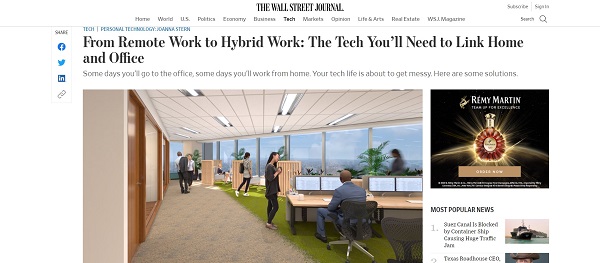
This article from The Wall Street Journal outlines the essential tools you’ll need to transition from remote work to hybrid work and link the home and office seamlessly to maximize productivity (and some challenges you might face along the way).
Three key points in From Remote Work to Hybrid Work: The Tech You’ll Need to Link Home and Office:
- Notable challenges with hybrid work (and potential solutions)
- Hybrid work will only further increase our reliance on tech tools
- How collaboration tools like Google, Slack, and Zoom are already preparing for the future of work
2. Rewiring how we work: building a new employee experience for a digital-first world
@SlackHQ
Focus: Business Strategy & Effectiveness
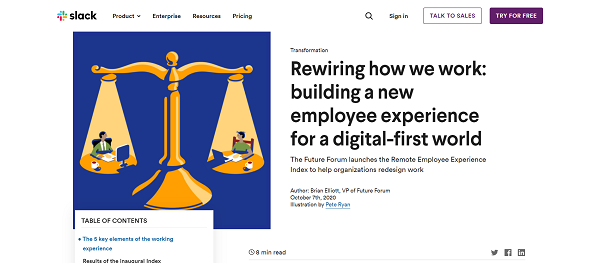
Slack’s Future Forum has launched a Remote Employee Experience Index, a quarterly report offering data and analysis to help organizations navigate the new, digital-first world of work. Based on data from 4,700 primarily remote workers from six countries, it measures factors such as productivity, work-life balance, and work satisfaction.
Three key points from Rewiring how we work: building a new employee experience for a digital-first world:
- Knowledge workers are more satisfied working remotely than working in-office
- Asynchronous communication works better than frequent meetings in the remote work world
- Executives and managers also face challenges when adapting to remote work
3. Moving beyond remote: Workplace transformation in the wake of Covid-19
@SlackHQ
Focus: Business Strategy & Effectiveness
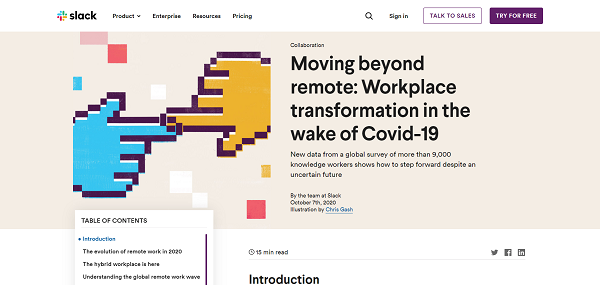
This article from Slack describes findings and takeaways from a global survey of more than 9,000 knowledge workers on the future of work and how companies can rethink the way teams work to support the new hybrid work model. It also includes findings from The Future Forum’s Remote Employee Experience Index.
Three key points from Moving beyond remote: Workplace transformation in the wake of Covid-19:
- Most knowledge workers prefer a hybrid approach: a mix of remote and in-office work
- Remote workers generally report more satisfaction, better work-life balance, and better productivity
- Connection (both logistical and relationships) is the biggest challenge to remote work
4. Question & Answer Employer Guide: Return to Work in the Time of COVID-19
@FaegreDrinker
Focus: Health & Physical Safety
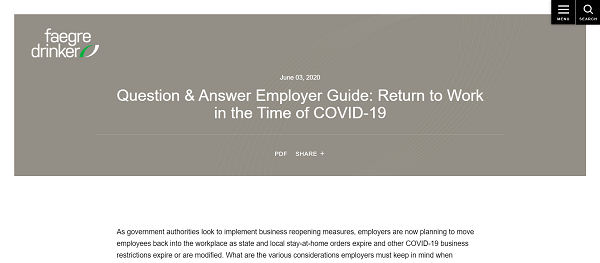
Faegre Drinker provides detailed answers to dozens of frequently asked questions from employers related to returning to work in the time of COVID-19. The questions and answers are organized by topic, making it easy to find the information you’re looking for whether you have questions about hiring or HR issues, employee benefits, sick leave or disability issues, the physical work environment, or other common concerns.
Three key points from Question & Answer Employer Guide: Return to Work in the Time of COVID-19:
- Document legitimate business reasons for determining which employees return to work first to prove non-discriminatory selection
- Clearly communicate all social distancing rules in clear language all employees can understand
- Consider virtual interviewing and onboarding for new hires
5. Key Considerations in Designing a Return to Work Plan
@ShearmanLaw
Focus: Health & Physical Safety
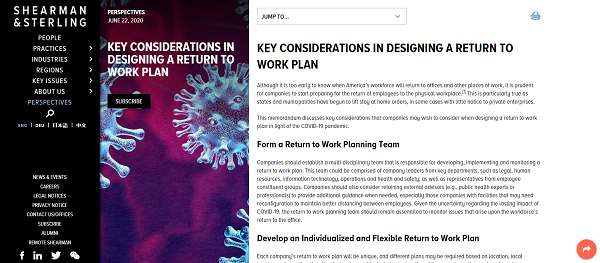
Shearman & Sterling outlines the key considerations for employers designing a plan for returning to work, including a summary of government guidelines for preparing the physical workplace, developing an ongoing monitoring and response plan, mitigating risks, and more.
Three key points from Key Considerations in Designing a Return to Work Plan:
- Follow all regulatory guidelines to minimize legal and regulatory risk
- Include processes for ongoing monitoring and how to address a large number of absences
- Be prepared to close the workplace quickly in response to outbreaks or public health orders
6. COVID-19 Return to Work Playbook
@aboutKP
Focus: Health & Physical Safety, Business Strategy & Effectiveness
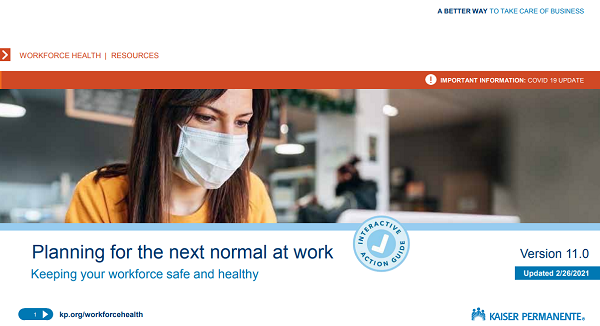
Kaiser Permanente’s Return to Work Playbook encompasses a range of considerations to address when developing and implementing a return to work plan. In addition to basic physical workplace safety considerations and employee health screenings, this guide also covers mental health and emotional well-being, updating HR policies to reflect the new normal, and more.
Three key points from COVID-19 Return to Work Playbook:
- Pandemics follow four distinct, predictable phases
- Tailor your safety plan to your workplace
- Continue remote work arrangements whenever possible
7. 5 Ways to Support Employees Returning to Work During COVID-19
@USChamber
Focus: Physical Health & Safety, Business Strategy & Effectiveness

The U.S. Chamber of Commerce discusses five ways employers can support employees returning to work during the COVID-19 pandemic, such as offering flexible scheduling or creative child care solutions, following best practices for sanitation and social distancing, and more.
Three key points from 5 Ways to Support Employees Returning to Work During COVID-19:
- Consider offering in-home care or virtual child care
- Provide allowances to help employees create a permanent home office
- Consider offering benefits to support employees’ mental health and well-being
8. Reopening safely: Sample practices from essential businesses
@McKinsey
Focus: Health & Physical Safety
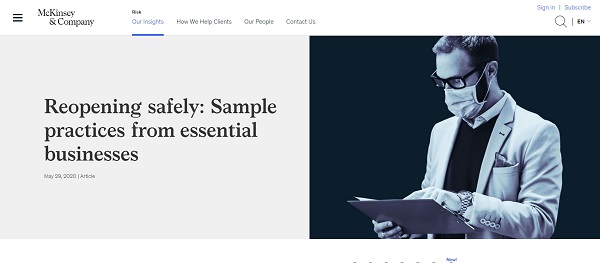
McKinsey & Company examines the policies and practices implemented by essential businesses to help non-essential businesses identify best practices that have proven effective in the workplace during the COVID-19 pandemic, including a discussion of the different needs and risk levels of different types of businesses and actions to consider before re-opening, for commuting to and from work, and at the workplace.
Three key points from Reopening safely: Sample practices from essential businesses:
- Continuing remote work when possible is the best way to mitigate risk
- Training and education are essential for instilling new habits among your workforce
- Consider staggered start and stop times to avoid crowding at entrances and exits
9. Strategies For Developing A Return To Work Action Plan
@seyfarthshawLLP
Focus: Health & Physical Safety, Business Strategy & Effectiveness
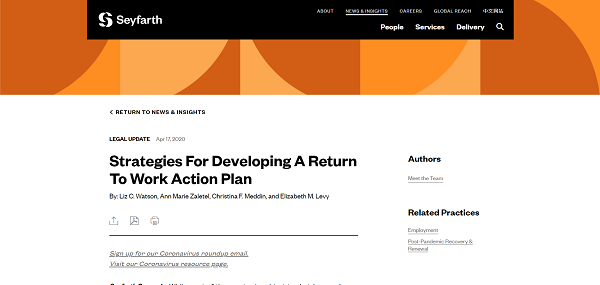
This article from Seyfarth discusses the key issues employers should consider when developing an action plan for returning to work, such as whether to implement a phased return and developing protocols to address logistical challenges such as transportation, child care, and employees who may be fearful of returning to the physical work environment.
Three key points from Strategies For Developing A Return To Work Action Plan:
- Develop an action plan for responding to an employee’s positive COVID-19 test
- Train and educate employees on new policies and procedures prior to returning to work
- Address employees’ expectations for continued flexibility for work location, hours, etc.
10. U.S. Privacy Law Implications for Employers Considering Employee Contact-Tracing Apps
@HuschBlackwell
Focus: Business Strategy & Effectiveness
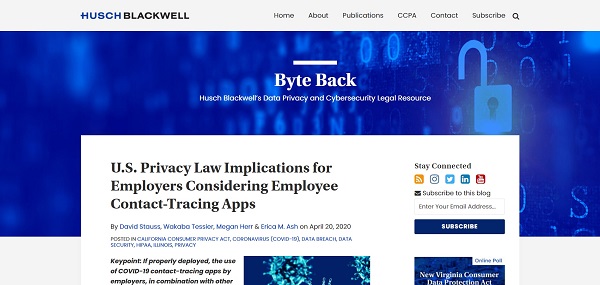
Contact tracing apps are getting a lot of attention as businesses are returning to work and looking for ways to maintain employees’ health and safety, but what legal and privacy implications arise from the use of these apps? This article from Husch Blackwell covers the ins and outs of contact tracing apps and how to properly vet applications to avoid violating privacy laws or assuming liabilities.
Three key points from U.S. Privacy Law Implications for Employers Considering Employee Contact-Tracing Apps:
- Contact tracing apps notify users if they’ve been in close contact with someone who tested positive for COVID-19
- The US and EU have different approaches to the development, vetting, and deployment of contact tracing apps
- Implement internal policies and procedures to ensure the proper use of contact tracing apps in your workplace
11. Return: A new muscle, not just a plan
@McKinsey
Focus: Business Strategy & Effectiveness

McKinsey & Company proposes an open-ended, flexible approach to the return to work rather than a definitive phase with a distinct point of completion. By developing a company-wide approach to absorbing uncertainty and adapting to change, companies can gain a competitive advantage in responding to future unanticipated disruptions.
Three key points from Return: A new muscle, not just a plan:
- Listen closely for signals such as shifts in consumer demand and brand loyalty
- Collect data from a wide range of sources
- Implement a plan-ahead team to stress-test and push for new capabilities and strategic moves
12. Question & Answer Employer Guide: Return to Work in the Time of COVID-19
@natlawreview
Focus: Physical Health & Safety
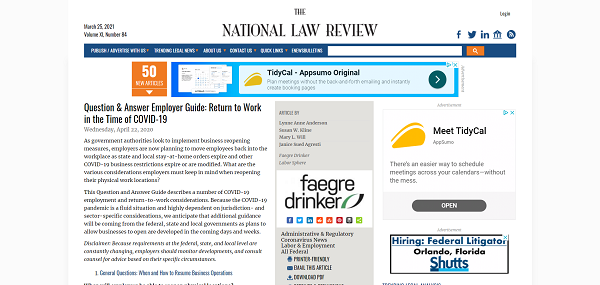
National Law Review provides answers to commonly asked questions related to the return to work, encompassing functional areas such as when to reopen, legal obligations to consider, social distancing guidelines, and resuming meetings, conferences, and business travel, among others.
Three key points from Question & Answer Employer Guide: Return to Work in the Time of COVID-19:
- Review existing policies to ensure compliance with updated guidelines and regulations
- Consider what supplies are needed for a safe return to work
- Ensure workplace screening is consistent with the Americans with Disabilities Act (ADA)
13. Communications get personal: How leaders can engage employees during a return to work
@McKinsey
Focus: Business Strategy & Effectiveness
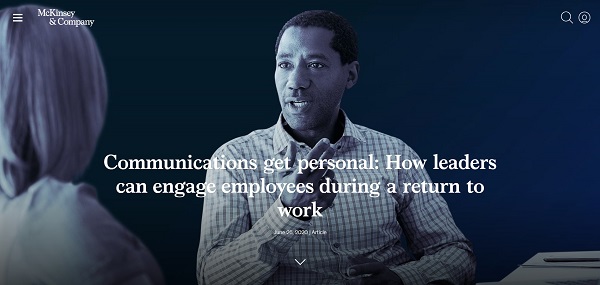
This article from McKinsey & Company discusses how leadership can engage employees more effectively during the return to work process, including four best practices to help leaders build trust and a sense of purpose.
Three key points from Communications get personal: How leaders can engage employees during a return to work:
- Clear and inspiring communication is key
- Be sensitive to employees’ needs
- Provide a “welcome back” kit to help employees navigate the new normal
14. Returning to Work in 2021: A New Hybrid Work Model after COVID-19
@Lifesize
Focus: Business Strategy & Effectiveness

Lifesize discusses the new hybrid work model emerging for many companies as businesses return to work and adapt to meet employees’ increased expectations for flexible work arrangements. Lifesize recommends embracing the hybrid work model, in which some employees work in the office and others work remotely, as well as other strategies for ensuring a smooth and safe transition to the new normal.
Three key points from Returning to Work in 2021: A New Hybrid Work Model after COVID-19:
- Allow employees to work from wherever they’re most comfortable and productive when possible
- Consider a rotational work schedule
- Ask employees for feedback to uncover what’s working and what needs improvement
15. COVID-19: Creating a Safe Workplace
@ClevelandClinic
Focus: Health & Physical Safety, Business Strategy & Effectiveness
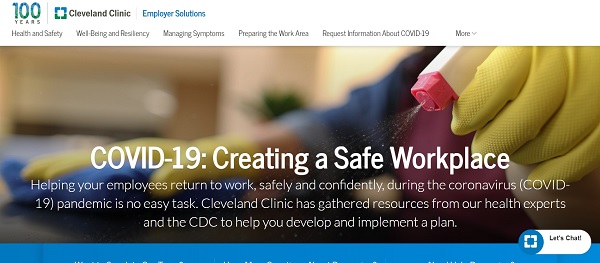
The Cleveland Clinic offers several guides focused on specific functional areas, such as cleaning and disinfection and communicating with empathy, to help employers facilitate a smooth transition back to work while ensuring a supportive and safe work environment. Industry-focused guides for retail, manufacturing, restaurants, healthcare providers, and other industries are also available.
Three key resources from COVID-19: Creating a Safe Workplace:
- Communicating and Managing with Empathy in a Time of Crisis
- Six Building Blocks of a Robust Cleaning and Disinfection Program
- Return to Work Amid COVID-19
16. FP Beyond the Curve: Back-To-Business FAQs For Employers
@labor_attorneys
Focus: Health & Physical Safety, Business Strategy & Effectiveness
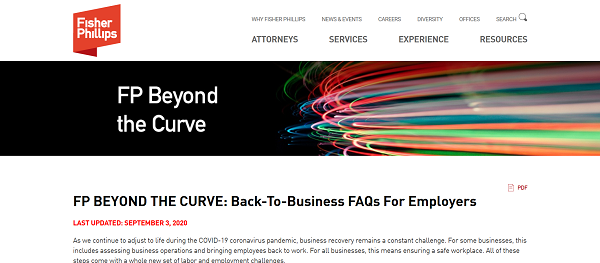
The Fisher Phillips Post-Pandemic Strategy group, a cross-disciplinary group of Fisher Phillips workplace attorneys, has compiled a comprehensive set of frequently asked questions to help guide employers during the return to work process. The answers to these questions provide actionable advice covering everything from general workplace safety measures to human resources, trade secrets and intellectual property considerations, workplace privacy, and more.
Three key points from FP Beyond the Curve: Back-To-Business FAQs For Employers:
- Follow federal, state, and local reporting requirements for rehires
- Consider data privacy for storing employee health screening data
- Communicate with both internal and external stakeholders
Return to Work Tools
17. COVID-19 Resources by State
@Paychex
Focus: Health & Physical Safety, Business Strategy & Effectiveness
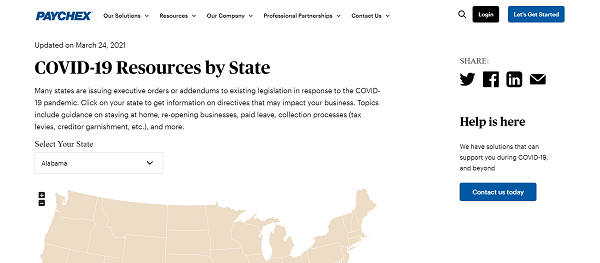
With the COVID-19 response in the U.S. handled largely at the state level, keeping up with the various executive orders and legislation enacted across multiple states is easier said than done. Paychex makes it easy to find all the relevant information and directives that may impact your business in any state with a simple drop-down menu.
Key Features:
- Simple drop-down menu to locate up-to-date resources and guidance for any state
- State-by-state guidance on rolling back and re-opening
- Links and contact information for state resources and agencies
Focus: Business Strategy & Effectiveness
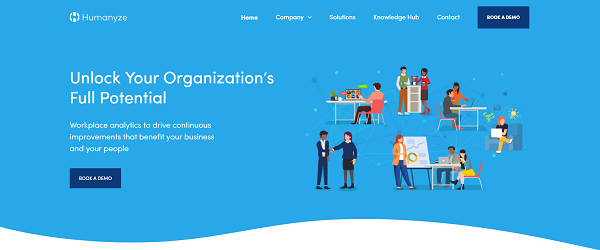
Humanyze’s workplace analytics help companies inform, validate, and improve decision-making by continuously measuring organizational effectiveness through the lens of collaboration. These insights have become even more critical during COVID-19, as companies are using the technology to uncover and improve the impacts of remote work on their organizations, as well as inform their return to work plan. By uncovering how work gets done and which behaviors, initiatives, or processes lead to success, Humanyze empowers leaders with the objective insights they need to create a healthier, more effective workplace.
Key Features:
- Identify opportunities for improvement using Indicators and Actionable Metrics in the categories of Engagement, Productivity, and Adaptability
- Integrate existing data from surveys, collaboration tools, and location systems
- GDPR/CCPA compliant and ensures employee anonymity
19. Work.com
@salesforce
Focus: Health & Physical Safety, Business Strategy & Effectiveness
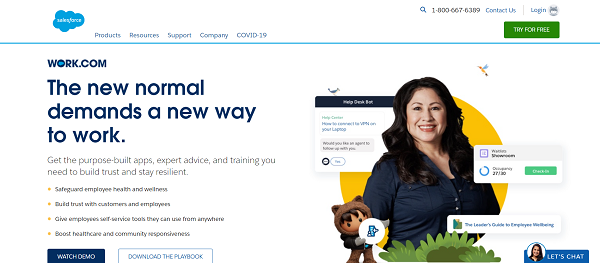
Salesforce’s Work.com platform has implemented a number of capabilities designed to help employers facilitate and manage a seamless return to work. The platform includes solutions for employee experience, workplace safety, trusted communications, and emergency response management.
Key Features:
- Shift management, contact tracing, and wellness checks
- Brings information and collaboration together in a single dashboard for employees
- Broadcast messaging to reach employees and customers efficiently
Focus: Health & Physical Safety
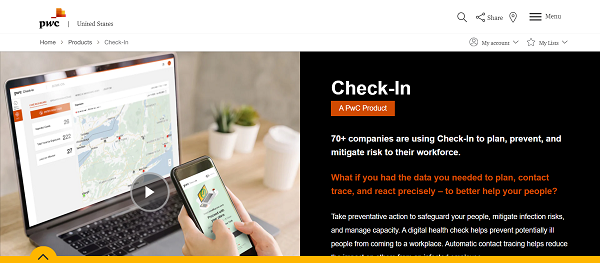
PwC’s Check-In helps companies plan, prevent, and mitigate risks to their workforce with digital health checks and automated contact tracing.
Key Features:
- Access and retention controls to protect employee data
- Encrypted record of self-reporting for risk assessment
- Available on laptops, desktops, and Android and iOS devices
21. Appian Workforce Safety
@Appian
Focus: Health & Physical Safety
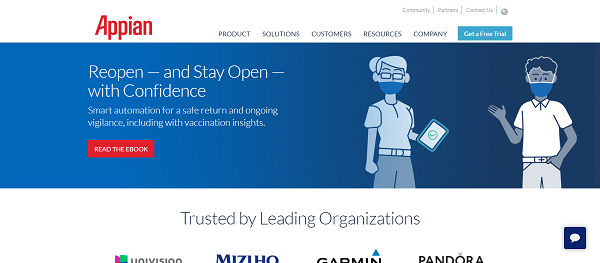
Appian Workforce Safety is a unified COVID-19 response hub with an automated and flexible approach to returning to onsite work safely. A single interface for managing workforce readiness, it includes a variety of features designed to support a safe return to work in accordance with local regulations.
Key Features:
- Incident case management
- Symptom and isolation monitoring
- Visitor and capacity management
Focus: Health & Physical Safety
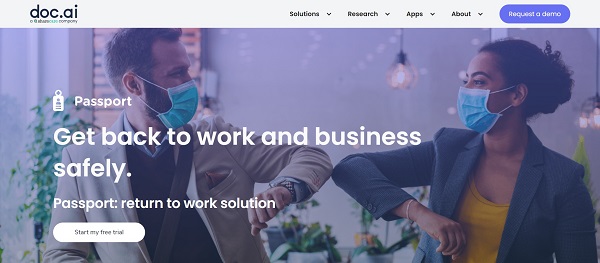
Doc.ai’s Passport helps businesses manage reopening from a single dashboard. It’s a secure app that can be customized with specific rules for each of your work locations.
Key Features:
- Employee check-ins generate a digital badge that’s valid for 24 hours
- Real-time analytics of successful check-ins
- Available on Android and iOS
23. The COVID-19 Health Status App
@EvidentID
Focus: Health & Physical Safety
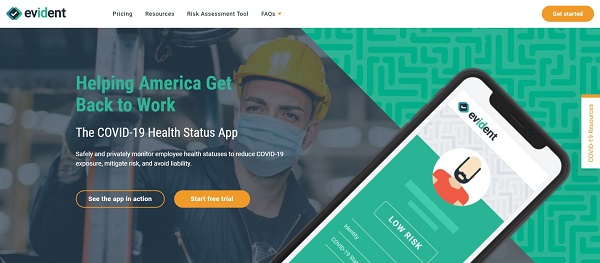
The COVID-19 Health Status App helps organizations monitor employee health status with streamlined employee surveys, contact tracing, workflow analysis, and more. Created by Evident, The COVID-19 Health Status App enables companies to identify health risks and communicate openly and transparently while protecting employee privacy and managing liability.
Key Features:
- Integrated policies and workflows
- Personal data encryption
- Comprehensive data collection and analytics
24. Coronavirus Preparedness
@Everbridge
Focus: Health & Physical Safety, Business Strategy & Effectiveness
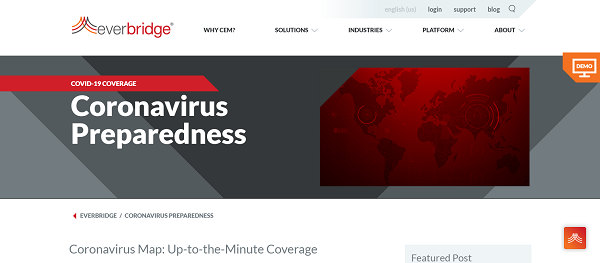
Everbridge offers a set of resources to help businesses protect their people and their operations as they return to work. With Everbridge’s Covid-19 Shield Return to Work Solutions, you can manage new outbreaks quickly, identify supply chain risks, and manage policies and procedures in one place.
Key Features:
- Up-to-date risk intelligence
- Correlate alerts to your impacted people, assets, and supply chain
- Employee wellness checks with a complete audit trail
25. SixFifty Return to Work Toolset
@sixfiftyhq
Focus: Health & Physical Safety, Business Strategy & Effectiveness
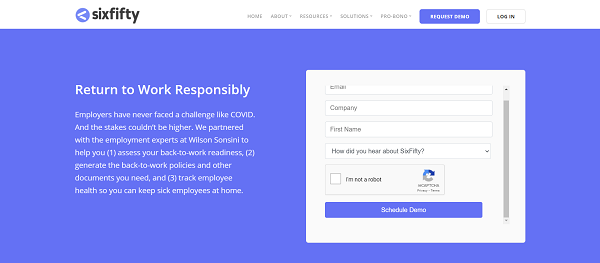
SixFifty partnered with Wilson Sonsini to develop a solution that helps businesses assess their back-to-work readiness, generate return to work policies and documents, and track employee health to prevent the spread of COVID-19.
Key Features:
- Return to work assessment
- Customizable return to work policies
- Daily online questionnaire for tracking employee health
26. Resuming Business Toolkit
@CDCgov
Focus: Health & Physical Safety
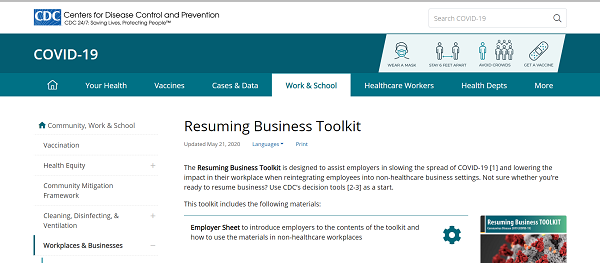
The CDC’s Resuming Business Toolkit is designed to help employers lower the impact in the workplace when returning to work. It includes decision tools to help you assess readiness, a tool for implementing worker protection measures, and other resources to help facilitate a seamless transition back to work.
Key Features:
- Restart Readiness Checklist
- Worker Protection Tool
- Returning to Work infographic to share with employees
27. GoCanvas Employee Health Screening and Vaccination Log
@GoCanvas
Focus: Health & Physical Safety

This Employee Health Screening and Vaccination Log from GoCanvas is a simple and easy to use tool to help you maintain compliance and ensure a safe environment for employees and customers.
Key Features:
- Track symptoms, temperature, and exposure
- Activate HIPAA compliance for added privacy and security
- Dynamic real-time reporting dashboard
28. COVID-19 Employee Self- Screening Solution
@mHCapps
Focus: Health & Physical Safety
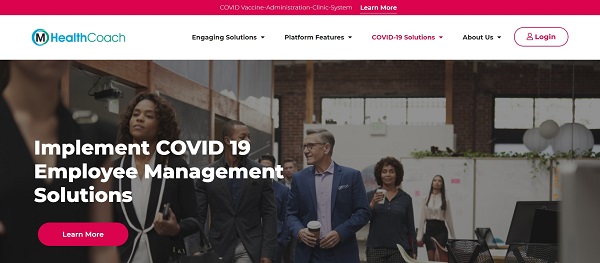
Employee screening is one of the most commonly implemented mitigation measures as businesses return to work, allowing employees exhibiting symptoms to isolate to prevent the spread of COVID-19 in the workplace. mHealthCoach’s COVID-19 Employee Self-Screening Solution streamlines the screening process as well as offers tools for managing testing and vaccinations.
Key Features:
- Simple employee self-screening for symptoms
- Monitor test records for employees
- Manage employees’ vaccination status
29. ProtectWell
Focus: Health & Physical Safety

A Microsoft and United Health Group collaboration, ProtectWell was designed using CDC guidance and was clinically developed by medical experts. It includes tools and resources for both individuals and administrators through a mobile app and web app.
Key Features:
- Employees can check symptoms and receive actionable advice
- Real-time updates to inform decision-making
- Scan users at the door to verify usage and ensure compliance
30. Healthy at Work
@verilylifesci
Focus: Health & Physical Safety

Healthy at Work, developed by Verily, offers a suite of tools for employers to help organizations operationalize their return to work. It combines clinical intelligence, data science, and a tech-enabled approach to personalized care to promote health and safety in shared spaces.
Key Features:
- Regular symptom screening
- Centralized results and analytics
- Population analytics to identify hotspots and trends
Focus: Health & Physical Safety
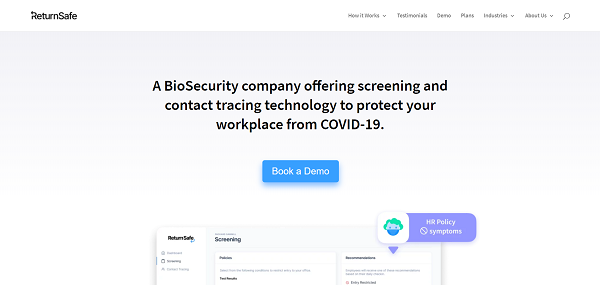
ReturnSafe is a biosecurity company specifically created to address COVID-19. ReturnSafe offers a HIPAA-compliant platform with screening and contact tracing technology to help businesses maintain a safe work environment and prevent COVID-19 outbreaks.
Key Features:
- Daily symptom screening
- Automated contact tracing
- Centralized portal for managing contact tracing and communications
32. COVID-19 Ready-Resource Tools and Samples
@SHRM
Focus: Health & Physical Safety, Business Strategy & Effectiveness
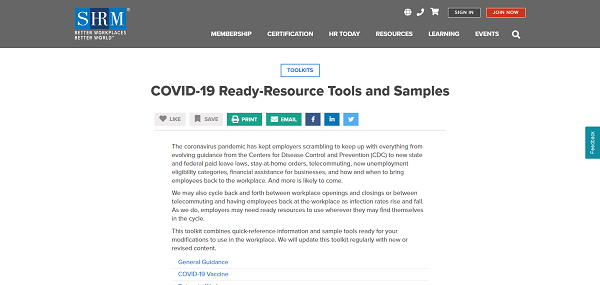
The Society for Human Resource Management offers a selection of quick reference resources to stay up to date on the latest guidance and regulations, sample forms, sample mandatory and voluntary vaccine policies, and more.
Three key resources from COVID-19 Ready-Resource Tools and Samples:
- Managing Flexible Work Arrangements
- COVID-19 Employee Health Screening Form
- COVID-19 In-House and Remote Work Arrangements Policy
33. COVID-19 Crisis Response Center
@RealThinkHR
Focus: Health & Physical Safety, Business Strategy & Effectiveness
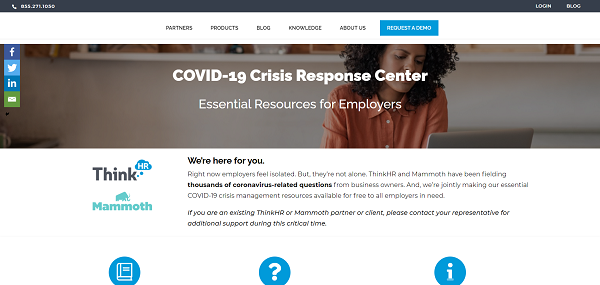
ThinkHR maintains a robust resource library in its COVID-19 Crisis Response Center, including sample policies and forms, videos and whitepapers, webinars, toolkits, and guides.
Three key resources from COVID-19 Crisis Response Center:
Return to Work Guidelines
34. Guidance for Businesses and Employers Responding to Coronavirus Disease 2019 (COVID-19)
@CDCgov
Focus: Health & Physical Safety
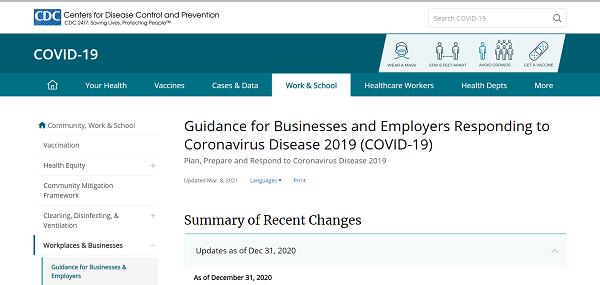
The Centers for Disease Control and Prevention (CDC) maintains comprehensive guidance for businesses and employers to help prevent the spread of COVID-19 in the workplace. The CDC’s guidelines cover everything from the role businesses and employers can play in responding to COVID-19 to specifics on screening, testing, and maintaining healthy business operations to communication, training, and policy development.
Three key topics in Guidance for Businesses and Employers Responding to Coronavirus Disease 2019 (COVID-19):
- Educating employees about the steps they can take to protect themselves at home and in the workplace
- Communicating supportive workplace policies
- Establishing social distancing practices and policies
35. What Employers Need to Do to Re-Open Post-COVID-19
@EHSToday
Focus: Health & Physical Safety
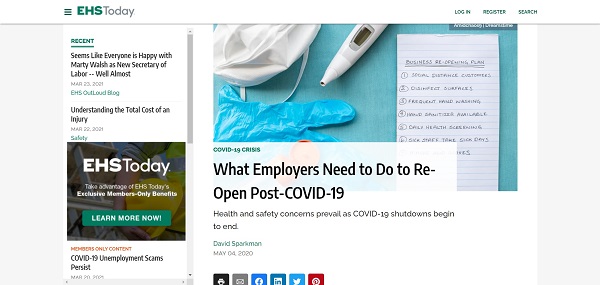
EHS Today outlines the key guidelines set forth by the CDC, the Occupational Safety and Health Administration (OSHA), and the Equal Employment Opportunity Commission (EEOC), as well as recommendations from experts for developing a plan to safely return to work as restrictions are lifted. The article includes valuable insights from attorneys from the law firms of Graydon Head & Ritchey, Bass, Berry & Sims, and Thompson Hine.
Three key topics in What Employers Need to Do to Re-Open Post-COVID-19:
- Questions employers should ask before developing a plan for employees to return to work
- The role of testing in returning to the physical office environment
- Preparing to respond to challenges when returning to work
36. Coronavirus Return to Work Guidelines, Checklist Included
@PaycorInc
Focus: Health & Physical Safety
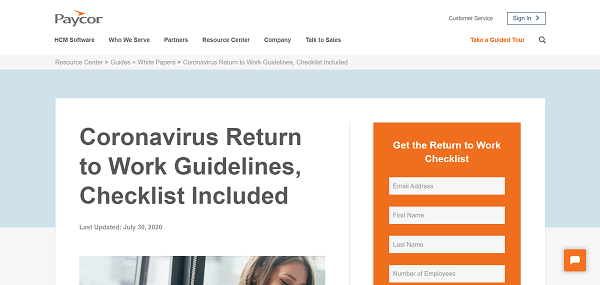
Paycor’s guidelines for returning to work include a summary of the CDC’s recommendations as well as suggestions for determining which employees should return to work first, considerations for implementing social distancing procedures, and handling symptoms and exposure to COVID-19.
Three key topics in Coronavirus Return to Work Guidelines, Checklist Included:
- How to handle employee exposure to COVID-19, positive tests, and returning to work after hospitalization
- Planning for virtual meetings where possible
- Considerations for continuing remote work
37. Considerations and Practicalities for Returning Employees to Work During a Pandemic
@Holland_Knight
Focus: Health & Physical Safety, Business Strategy & Effectiveness
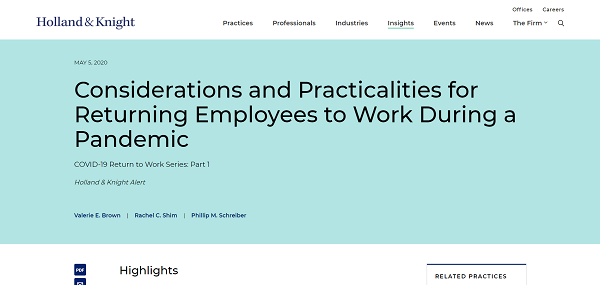
Holland & Knight discusses important considerations for businesses to weigh as restrictions are lifted and more non-essential businesses can begin reopening. These guidelines cover not only the health and physical safety considerations for returning to work but also other factors such as logistical challenges and health coverage.
Three key topics in Considerations and Practicalities for Returning Employees to Work During a Pandemic:
- Ensuring group health plan coverage complies with FFCRA and the CARES Act requirements
- Mental health concerns employers should keep in mind as employees return to work
- Logistical challenges in ensuring employees can maintain social distancing
38. Returning Employees to Work: What Should US Employers Think About?
@arnoldporter
Focus: Health & Physical Safety
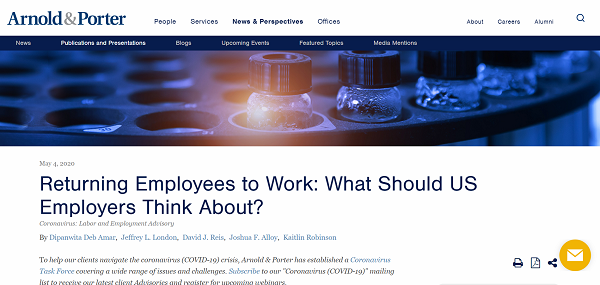
Arnold & Porter examines a number of factors businesses should consider as employees return to work. These guidelines and considerations focus primarily on labor implications, such as liability for businesses should an employee contract COVID-19 in the workplace, hiring, and leaves of absence.
Three key topics in Returning Employees to Work: What Should US Employers Think About?:
- Maintaining a safe physical work environment
- Federal, state, and local employee rights to leaves of absence
- Worker’s compensation and civil liability for employees who contract COVID-19 at work
39. OSHA Guidance on Returning to Work
@OSHA_DOL
Focus: Health & Physical Safety

These guidelines from the Occupational Health and Safety Administration (OSHA) aren’t standards or regulations, but rather recommendations and descriptions of mandatory standards related to workplace health and safety. The guide includes answers to employer frequently asked questions, a summary of the applicable OSHA standards and protections employers are required to implement in the workplace, and information on OSHA programs and services.
Three key topics in OSHA Guidance on Returning to Work:
- What employers should do during each reopening phase
- Examples of how to implement guiding principles such as hygiene and social distancing
- Answers to questions about what employers can do regarding on-site testing, health screenings, and more
40. COVID-19 Pandemic: Employer Re-Opening and Return to Work Guidelines
@Crowell_Moring
Focus: Health & Physical Safety, Business Strategy & Effectiveness
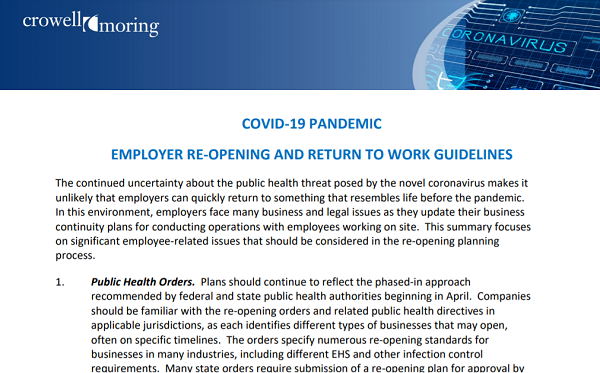
This guide from Crowell & Moring outlines 21 significant employee-related issues that businesses should consider when developing return to work plans, including legal and regulatory considerations such as public health orders and current regulatory guidance and operational considerations such as re-staffing and telework.
Three key topics in COVID-19 Pandemic: Employer Re-Opening and Return to Work Guidelines:
- Developing policies that address employee fears and concerns
- Employee cohort strategies
- Revising existing workplace policies and procedures
41. Back to Work Safely™
@Back2WorkSafely
Focus: Health & Physical Safety
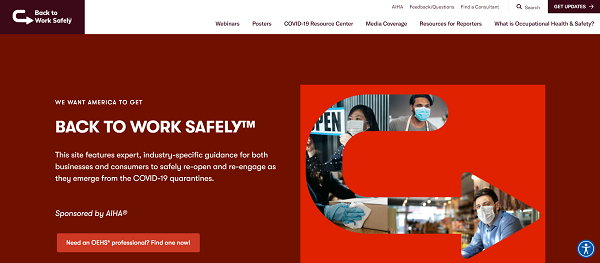
Back to Work Safely™ is sponsored by the American Industrial Hygiene Association (AIHA). The website is a comprehensive resource for health and physical safety guidelines, offering detailed re-opening guidelines for a variety of industries including bars and restaurants, business services, amateur sports, laboratories, higher education institutions, and many others.
Three key resources from Back to Work Safely™:
- Industry-specific re-opening guidelines
- Webinars addressing common re-opening challenges in various industries
- Downloadable posters to communicate health & safety best practices in the workplace
42. The Executive’s Guide to Returning to the Workplace
@Gartner_inc
Focus: Business Strategy & Effectiveness

This guide from Gartner offers valuable insights for executives who are spearheading return to work planning for their organizations. It offers research-backed guidance on preparing the workplace and employees to return to work, developing a re-exit plan, and options for safely phasing-in a return to the workplace.
Three key topics in The Executive’s Guide to Returning to the Workplace:
- How to segment your workforce to determine who should return to the office and when
- How to maximize the effectiveness of remote work
- Understanding personas to design a positive return to workplace experience
43. Reopening Workplaces Amid COVID-19: Key Considerations for Non-Essential Businesses
@natlawreview
Focus: Health & Physical Safety

National Law Review provides a comprehensive summary of the guidelines for returning to work for non-essential businesses from regulatory and government agencies, including the CDC and OSHA, as well as state-specific guidance and possible legal consequences, such as enforcement actions.
Three key topics in Reopening Workplaces Amid COVID-19: Key Considerations for Non-Essential Businesses:
- A summary of OSHA’s guidance, recommendations, and requirements
- OSHA’s guiding principles and phases for re-opening
- Information on OSHA-approved State Plans covering private sector and/or state and local government workers
Return to Work Checklists
44. Return to the Workplace
@PwC
Focus: Health & Physical Safety, Business Strategy & Effectiveness
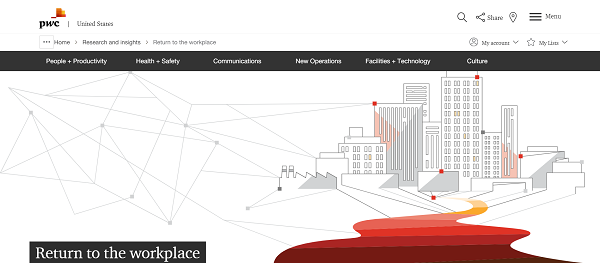
PwC’s Return to the Workplace checklist includes actionable steps in several categories such as strategy development, operating under and adapting to changing conditions, and developing policies and procedures.
Three key points from Return to the Workplace:
- Consider technology to monitor for critical events that may impact transition plans
- Consider behavioral predictors to analyze health risks
- Accelerate digital and adopt new remote ways of working
45. COVID-19 Return-to-Work Guidance for Businesses
@AgilityRecovery
Focus: Health & Physical Safety, Business Strategy & Effectiveness
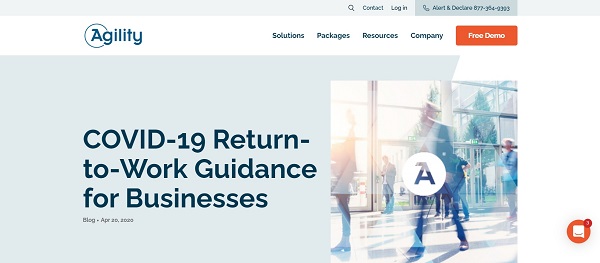
Agility Recovery outlines the key steps for preparing your workplace and employees for the return to work, covering steps and considerations for developing a return to work plan, strategies for a phased employee return, employee education and communication, and more.
Three key points from COVID-19 Return-to-Work Guidance for Businesses:
- Establish a planning and response team
- Implement workplace design changes and gathering alternatives or policies
- Train employees on best practices to prevent the spread of COVID-19
46. COVID-19 Back-to-Work Checklist
@SHRM
Focus: Health & Physical Safety, Business Strategy & Effectiveness

The Society for Human Resource Management (SHRM) provides action steps across 10 key issues including communications, compensation, remote work, workplace safety, employee benefits, recall procedures, new hire paperwork, policy changes, business continuity plans, and unions.
Three key points from COVID-19 Back-to-Work Checklist:
- Implement a business continuity plan that includes infectious disease control
- Adjust paid leave policies to comply with regulatory requirements and business needs
- Update technology to support remote workers
47. 8 Return-to-Work Considerations for Employers Amid COVID-19
@avalerehealth
Focus: Health & Physical Safety

Avalere points out that businesses will need to be resilient, flexible, innovative, and forward-looking to thrive in a post-COVID-19 world. Their checklist covers workforce assessments, coordination with officials on local conditions, compliance and legal standards, and other essential considerations for employers to address when returning to work.
Three key points from 8 Return-to-Work Considerations for Employers Amid COVID-19:
- Place posters in visible areas to reinforce hygiene messaging
- Find ways to balance data privacy with public health and safety
- Make improvements to air exchange and air filtration in the physical workplace
48. Protecting Workers: Guidance on Mitigating and Preventing the Spread of COVID-19 in the Workplace
@OSHA_DOL
Focus: Health & Physical Safety

This detailed checklist from OSHA is designed to help employers identify the risks of COVID-19 exposure in the workplace and determine the most appropriate control measures to implement to maintain a safe physical work environment.
Three key points from Protecting Workers: Guidance on Mitigating and Preventing the Spread of COVID-19 in the Workplace:
- Identify where and how workers might be exposed to COVID-19 in the workplace
- Allow workers who are isolating or quarantining to work remotely when possible
- Set up an anonymous process for workers to voice concerns about COVID-19-related hazards
49. 7 Early Return-to-Workplace Lessons from Asia
@Gartner_inc
Focus: Health & Physical Safety, Business Strategy & Effectiveness

Gartner outlines seven lessons learned from employers that have returned to work in Asia that employers in other parts of the world can follow to ease the transition back to work.
Three key points from 7 Early Return-to-Workplace Lessons from Asia:
- Monitor employee data to inform return to work plans
- Maintain frequent two-way communication with employees
- Formalize successes from remote work into best practices to improve productivity
50. Return to Business and Post-Pandemic Planning Checklist
@seyfarthshawLLP
Focus: Health & Physical Safety, Business Strategy & Effectiveness
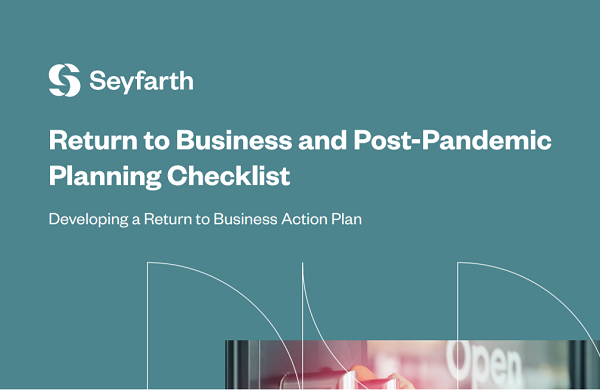
Seyfarth’s checklist for returning to work and post-pandemic planning covers logistical concerns to address before returning to work, addressing concerns related to customers, vendors, and visitors, tax implications, corporate governance, and other essential considerations to help employers plan a safe and functional return to the workplace.
Three key points from Return to Business and Post-Pandemic Planning Checklist:
- Use past experiences to inform future decisions
- Remain flexible and continue to adapt your plan to meet changing needs and requirements
- Develop a process for approving telework requests

